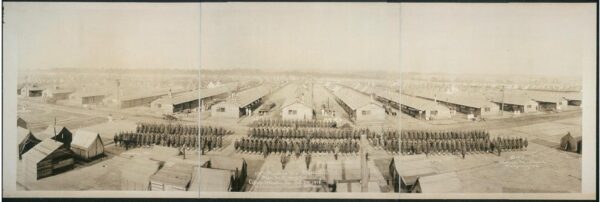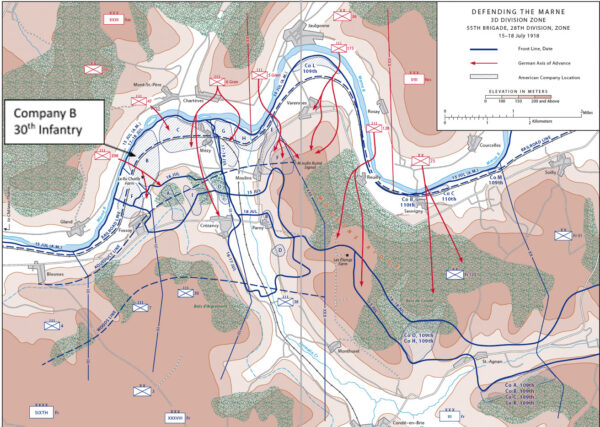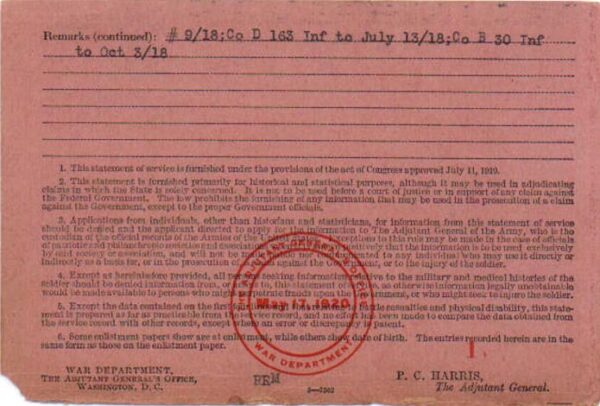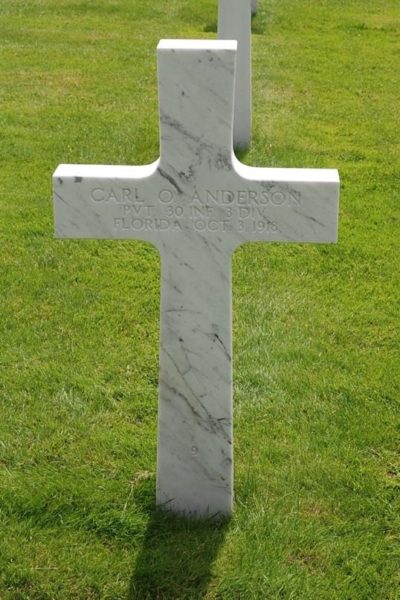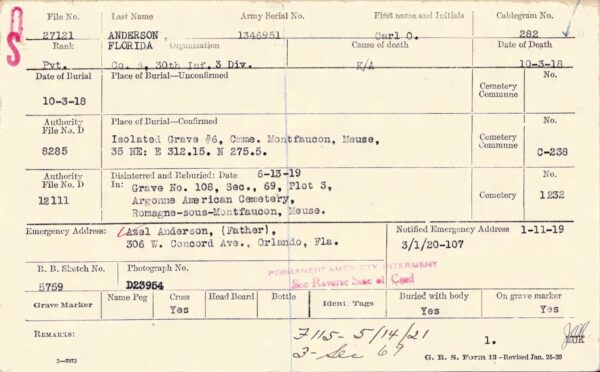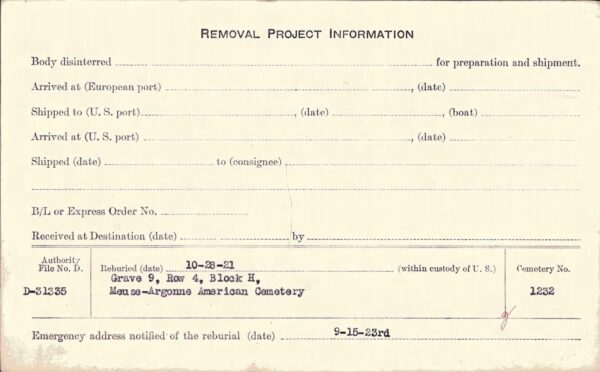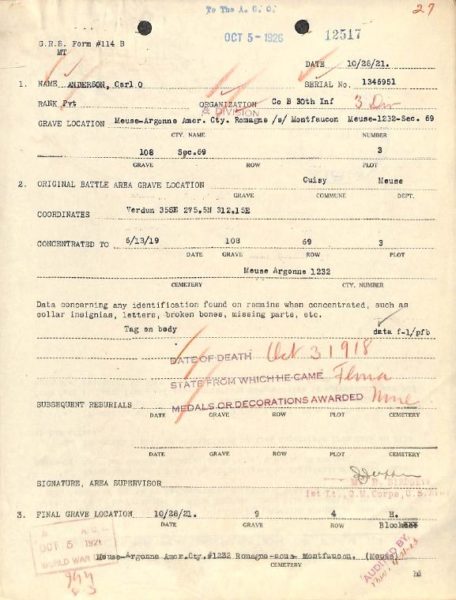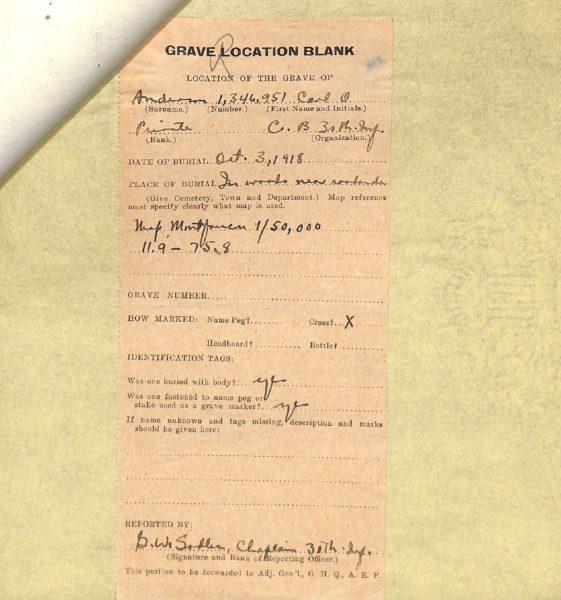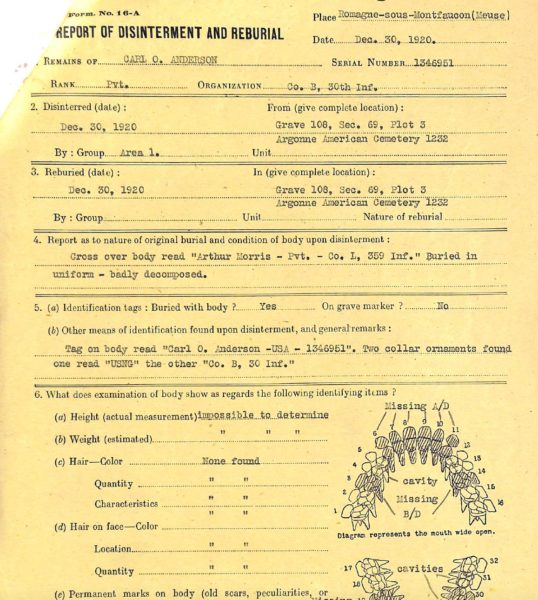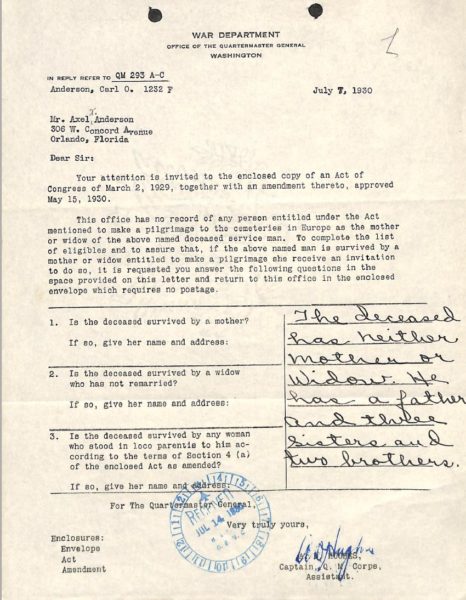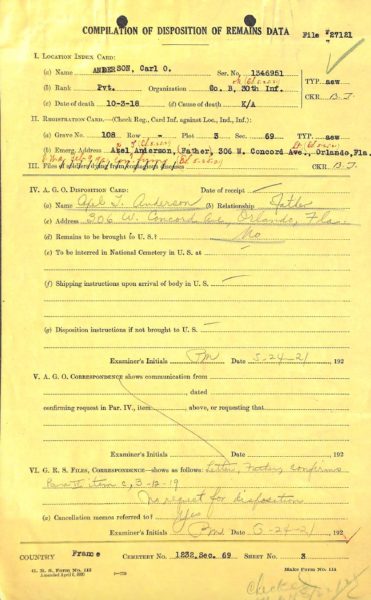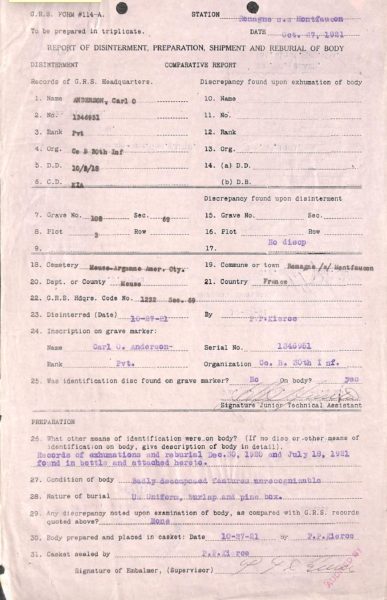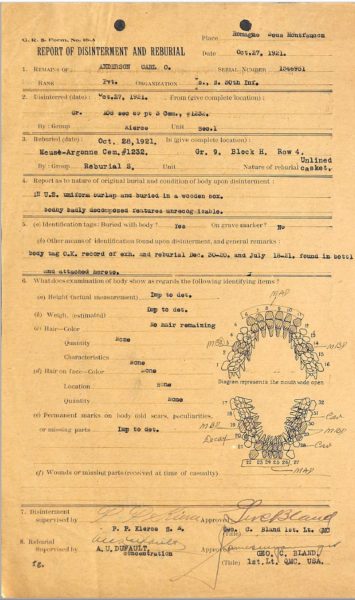Scroll 1 # 15
Carl Oscar Anderson was born on March 3, 1892, in Orange County, Florida. Anderson’s parents, Axel Teodor Anderson (1858-1937) and Anna Augusta Wilhelmina Elisabet Nilsson (1864-1903), were Swedish immigrants who came to the United States in the 1880s. The family settled near Maitland, where they purchased a farm and managed citrus groves. The Andersons had six children, three boys and three girls: Carl and his older brothers, Fred (1887-1937) and Roy Adrian (1889-1975), and younger sisters, Ida (born 1895), Anna Sophia (1897-1989), and Alice Florence (1901-1991). By 1910, Carl and four of his siblings were living on the family farm near Maitland. Sometime around 1913, Anderson moved to Miami where he worked for the Melrose Dairy owned by Joachim Fritz. While in Miami, he registered for the draft on June 5, 1917; he was formally inducted into the Army on October 6, 1917.
Anderson was first sent to Camp Jackson, near Columbia, South Carolina, for several weeks of basic training, and was transferred to Camp Wheeler, Macon, Georgia in late October 1917 at a time when the base was experiencing a measles epidemic. At Wheeler, he served in two different companies in the 124th Infantry, which consisted primarily of fellow Floridians, and he spent several months in a machine gun battalion that was about half Floridian. Finally, in June 1918, Anderson was ordered to France as a replacement. Taking a train to New York City, he embarked on the troop transport HMAT Euripides for England. Once “over there,” Anderson spent six weeks assigned to Company D, 163rd Infantry, 41st Division until July 13, 1918, when he received his final transfer to Company B, 30th Infantry, 3rd Division.
Panoramic photograph of the 118th Machine Battalion at Camp Wheeler in February 1918, when Anderson served in the unit.
Based in Australia, the former commercial liner Euripides completed seven voyages carrying Allied troops between Sydney and England from 1915 to 1919.
In the annals of American military history, one of the nation’s finest and most decorated unit is the 3rd Infantry Division. The core of the 3rd Infantry Division has traditionally been composed of three infantry regiments: the 7th, 15th and 30th. Formed over one hundred years earlier, the 30th Infantry Regiment had been involved in nearly every military action undertaken by the United States, except for the Mexican War. It had participated in the American Civil War and gained recognition in places like Bull Run, Antietam, Chancellorsville, and Gettysburg. In the early 1900s, it had seen duty in the Philippines. The 30th would again be deployed in 1917 as part of the American Expeditionary Forces in France. Its commander was Col. Edmund Luther (“Billy”) Butts, a graduate of West Point, Class of 1890, one of the youngest regimental commanders in the A.E.F. While still a first lieutenant in 1897, Butts authored a Manual for Physical Drill, known as the “Butts Manual,” that consisted of a regimen of calisthenics and core training exercises, including rifle drills, rope climbing, and the use of dumbbells, which were adopted by the Army. Along with the 38th Infantry Regiment and the 9th Machine Gun Battalion, the 30th formed the 3rd Infantry Division’s 6th Infantry Brigade.
Anderson joined the 30th Infantry as it occupied the Château-Thierry sector (Champagne) south of the Marne River. Company B was dug in along a railroad line between Mézy and Fossoy, about 5 miles east of Château-Thierry. One of the final German pushes of the war occurred in the early morning hours of July 15, 1918, when German assault troops and artillery pounded the U.S. 3rd Division lines. The weight of the attack came against Butts’ 30th Infantry and Col. Ulysses Grant McAlexander’s 38th Infantry. After heavy fighting in the morning, when the 30th Infantry “inflicted horrendous casualties” on the Germans, Butts’ men were forced back to a line along the hills where they stopped the Germans. Although fighting on three sides, the riflemen and machine gunners of the 38th Infantry held their ground, earning the sobriquet “Rock of the Marne.” The 3rd Infantry Division is still known by that moniker today, with the 30th’s additional motto of “Our Country Not Ourselves.” By the end of that July 15th day, the 3rd Division had stopped the German attack. Together, the 30th Infantry and 38th Infantry had defeated six regiments from two German divisions, while suffering many casualties themselves. From July 15 to 17, the 3rd Division lost 3,151 men, more than 10% of its force, with 606 killed in action.
3rd U.S. Division in Champagne-Aisne Defense, July 15-18, 1918.
Following the Champagne-Marne defensive, from July 15-18, 1918, Anderson participated in the Aisne-Marne counteroffensive from July 18 to August 6. Together, both operations constituted the Second Battle of the Marne. On the night of July 22, the 6th brigade crossed the Marne River at Mézy and captured the small village of Jaulgonne, about eight miles east of Château-Thierry along the Marne River. We know that Private Anderson was part of this operation because “jaulgone” [sic] is listed on his service card beside “Engagements.” Anderson presumably remained with his unit from August 2 through 11 when the 6th Brigade was dispatched to support of the French Third Army Corps operating toward the Vesle River. Afterwards, the 6th spent time in rear areas near Gondrecourt and later Vaucouleurs for “rehabilitation and training,” before joining in the St. Mihiel operation of September 12-15 and the start of the Meuse-Argonne offensive later that month.
Front and back of Carl O. Anderson’s Florida “Death” Card, summarizing his military career.
It was during the latter, as the 6th attacked and advanced against the enemy, that Private Anderson was killed in action on October 3, 1918. On that day, the 30th rushed about seven miles north from the Bois de Montfaucon to the Bois de Beuge in order to support the 4th Infantry, which faced intense shelling in their wooded position and suffered heavy casualties. Anderson probably died during this advance to Bois de Beuge.
Carl Anderson’s body was hastily buried by some of his comrades on October 3, 1918, in an isolated grave “in woods near [a] roadside” not far from Commune Montfaucon, Meuse, as reported by the 30th Infantry chaplain. After the fighting was over, on June 13, 1919, his remains were wrapped in a burlap sack and placed in a pine box in Grave 108, Sec 69, Plot 3 of Argonne American Cemetery #1232. Disinterred on December 30, 1920, there was some confusion over his identity. The cross over his grave read “Arthur Morris Pvt Co L 359th Infantry.” But the dog tag on the badly composed body in a uniform read “Carl O. Anderson — 1346951,” and collar insignia indicated Company B 30th Infantry. A dental exam also showed that Anderson was missing six front upper teeth and two molars, and he had several cavities. His identity confirmed, he was reburied in the same plot. Disinterred again on July 18, 1921, his identity was reconfirmed, and he was placed in the same plot. Disinterred a fourth time on October 27, 1921, he was reburied in Grave 9, Row 4, Block H, Meuse-Argonne Cemetery, Romagne-sous-Montfaucon, France. The saga of Anderson’s multiple burials and identity confirmations are found in his rather large Graves Registration file. His story, like his multiple assignments in different military units, is not uncommon.
Although no names were inscribed on the Lake Eola Tablet dedicated by the DAR in 1924, Carl O. Anderson was included among the 23 “Orange County boys who gave their lives in the World War.” His sacrifice is also commemorated on the war memorial constructed outside the Orange County Courthouse, in the Central Florida Veterans Memorial Park at Lake Nona, dedicated in 2013, and at the Montfaucon Monument in France.
Orlando Sentinel, November 11, 1924
Orlando Sentinel, November 28, 1918
Anderson’s grave today, Meuse-Argonne Cemetery, Romagne-sous-Montfaucon, France.
Burial Case File



